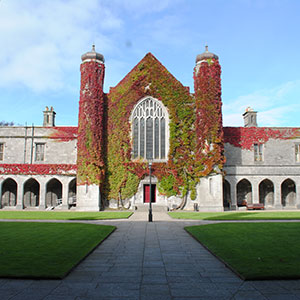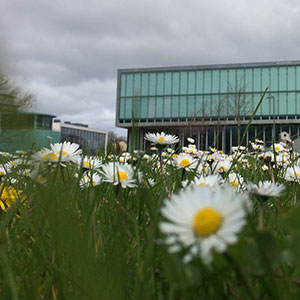-
Courses

Courses
Choosing a course is one of the most important decisions you'll ever make! View our courses and see what our students and lecturers have to say about the courses you are interested in at the links below.
-
University Life

University Life
Each year more than 4,000 choose University of Galway as their University of choice. Find out what life at University of Galway is all about here.
-
About University of Galway

About University of Galway
Since 1845, University of Galway has been sharing the highest quality teaching and research with Ireland and the world. Find out what makes our University so special – from our distinguished history to the latest news and campus developments.
-
Colleges & Schools

Colleges & Schools
University of Galway has earned international recognition as a research-led university with a commitment to top quality teaching across a range of key areas of expertise.
-
Research & Innovation

Research & Innovation
University of Galway’s vibrant research community take on some of the most pressing challenges of our times.
-
Business & Industry

Guiding Breakthrough Research at University of Galway
We explore and facilitate commercial opportunities for the research community at University of Galway, as well as facilitating industry partnership.
-
Alumni & Friends

Alumni & Friends
There are 128,000 University of Galway alumni worldwide. Stay connected to your alumni community! Join our social networks and update your details online.
-
Community Engagement

Community Engagement
At University of Galway, we believe that the best learning takes place when you apply what you learn in a real world context. That's why many of our courses include work placements or community projects.
Staff Profiles
Dr Aoife Boyd
Contact Details
Department of Microbiology
School of Natural Science
Arts/Science Building
H91 TK33
E: Aoife.Boyd@UniversityOfGalway.ie

Biography
Research Interests
Research Projects
| Project | Start Date | End Date | |
|---|---|---|---|
| IRC POSTGRADUATE SCHOLARSHIP 2020 LAURA CUTUGNO: GENETIC CHARACTERISATION OF THE VIBRIO VULNIFICUS STRESSOSOME AND ITS ROLE IN STRESS RESPONSE AND VIRULENCE | 01-OCT-20 | 30-SEP-26 | |
| SFI Research Frontiers Programme - 2008-2012: Role of JNK Activation in the Pathogenesis of Vibrio parahaemolyticus | 01-SEP-08 | 15-OCT-13 | |
| SFI Research Frontiers Programme - 2008-2012 Molecular mechanism of interaction between human epithelial cells and the gastrointestinal pathogen, Vibrio parahaemolyticus | 01-SEP-08 | 15-OCT-13 | |
| SFI UREKA (Undergraduate Research Experience & Knowledge Award) site - 2008-2010 Programme for the Encouragement and Training of Undergraduate Students to Pursue Future Careers in Infectious Disease Research | 01-FEB-08 | 31-JAN-11 | |
| SFI UREKA Site Supplement 2006-2008: Student Exchange between NUIG Infectious Disease UREKA Programme and University of Georgia, Athens, USA Prokaryotic Biology REU Site | 01-APR-06 | 01-APR-09 | |
| EU 6th Framework Marie Curie Transfer of Knowledge Grant 2005-2010: Transfer of Knowledge required to understand cross-talk between host and pathogen during gastrointestinal infections in humans (GAMIDI) | 01-SEP-05 | 01-SEP-11 | |
| SFI UREKA (Undergraduate Research Experience & Knowledge Award) site - 2005-2007 Programme for the Encouragement and Training of Undergraduate Students to Pursue Future Careers in Infectious Disease Research | 01-FEB-05 | 31-JAN-08 | |
| IRCSET Basic Research Grant - 2002-2005: Modulation of the Host Immune Response by Effector Proteins of the Type III Secretion System of Bordetella pertussis | 01-SEP-02 | 20-JAN-07 | |
| DAFM - Genomics to Investigate Risks of Toxin-Producing Vibrio in Irish Shellfish | 01-FEB-20 | 31-OCT-22 | |
| IRC POSTGRADUATE SCHOLARSHIP 2017 - MD NEYAZ KNAN - VIRULENCE MECHANISMS OF PATHOGENIC BACTERIA AS TARGETS FOR BIODISCOVERY: IDENTIFICATION AND CHARACTERIZATION OF ANTI-VIRULENCE MOLECULES FROM MARINE SPONGES | 01-OCT-17 | 30-SEP-21 | |
| TOXINS+HUMAN CELL RESPONSES | 20-OCT-05 | 28-FEB-07 | |
| MF2004 MF85 04 M AOIFE BOYD | 21-SEP-04 | 20-SEP-05 | |
| TYPE III SECRETION SYSTEMS A BOYD | 10-MAY-04 | 31-DEC-22 |
Peer Reviewed Journals
| Year | Publication | |
|---|---|---|
| (2023) | 'Sponge-derived fatty acids inhibit biofilm formation of MRSA and MSSA by down-regulating biofilm-related genes specific to each pathogen'
Khan N, Barthes N, McCormack G, O'Gara JP, Thomas O, Boyd A (2023) 'Sponge-derived fatty acids inhibit biofilm formation of MRSA and MSSA by down-regulating biofilm-related genes specific to each pathogen'. Journal Of Applied Microbiology, 134 [DOI] [Details] |
|
| (2023) | 'Inhibition of bacterial biofilms by the snake venom proteome'
Khan, Neyaz A. and Amorim, Fernanda G. and Dunbar, John P. and Leonard, Dayle and Redureau, Damien and Quinton, Loïc and Dugon, Michel M. and Boyd, Aoife (2023) 'Inhibition of bacterial biofilms by the snake venom proteome'. Biotechnology Reports, 39 [DOI] [Details] |
|
| (2023) | 'The Vibrio vulnificus stressosome is dispensable in nutrient-rich media'
Cutugno, L, Mc Cafferty, J, Pane-Farre, Jan, O'Byrne, C, Boyd, A. (2023) 'The Vibrio vulnificus stressosome is dispensable in nutrient-rich media'. Access Microbiology, 5 (7) [DOI] [Details] |
|
| (2023) | 'In vivo characterisation of the Vibrio vulnificus stressosome: A complex involved in reshaping glucose metabolism and motility regulation, in nutrient- and iron-limited growth conditions'
Cutugno, Laura and Tamayo, Borja Khatabi Soliman and Lens, Piet N.L. and O'Byrne, Conor and Pané-Farré, Jan and Boyd, Aoife (2023) 'In vivo characterisation of the Vibrio vulnificus stressosome: A complex involved in reshaping glucose metabolism and motility regulation, in nutrient- and iron-limited growth conditions'. Current Research in Microbial Sciences, 4 [DOI] [Details] |
|
| (2023) | 'Rifampicin-resistant RpoB S522L Vibrio vulnificus exhibits disturbed stress response and hypervirulence traits'
Cutugno, L, O'Byrne, C, Pane-Farre, J, Boyd, A. (2023) 'Rifampicin-resistant RpoB S522L Vibrio vulnificus exhibits disturbed stress response and hypervirulence traits'. Microbiologyopen, 12 (5) [DOI] [Details] |
|
| (2023) | 'Venom extraction method influences venom composition and potency in the giant house spider Eratigena atrica (C. L. Koch, 1843)'
Lyons, K, Dugon, MM, Boyd, A and Healy, K (2023) 'Venom extraction method influences venom composition and potency in the giant house spider Eratigena atrica (C. L. Koch, 1843)'. Toxicon, 234 [DOI] [Details] |
|
| (2022) | 'Bis-Indole Alkaloids Isolated from the Sponge Spongosorites calcicola Disrupt Cell Membranes of MRSA'
Khan, NA; Kaur, N; Owens, P; Thomas, OP; Boyd, A. (2022) 'Bis-Indole Alkaloids Isolated from the Sponge Spongosorites calcicola Disrupt Cell Membranes of MRSA'. International Journal Of Molecular Sciences, 23 (4) [DOI] [Details] |
|
| (2022) | 'Validation of a random Vibrio parahaemolyticus genomic library by selection of quinolone resistance in a heterologous host'
O'Boyle, N.; Boyd, A. (2022) 'Validation of a random Vibrio parahaemolyticus genomic library by selection of quinolone resistance in a heterologous host'. Microbiology, 168 (5) [DOI] [Details] |
|
| (2022) | 'The Vibrio vulnificus stressosome is an oxygen-sensor involved in regulating iron metabolism'
Heinz, V, Jackel, W, Kaltwasser, S, Cutugno, L, Bedrunka, P, Graf, A, Reder, A, Michalik, S, Dhople, VM, Madej, MG, Conway, M, Lechner, M, Riedel, K, Bange, G, Boyd, A, Volker, U, Lewis, RJ, Marles-Wright, J, Ziegler, C and Pane-Farre, J (2022) 'The Vibrio vulnificus stressosome is an oxygen-sensor involved in regulating iron metabolism'. Communications Biology, 5 (1) [DOI] [Details] |
|
| (2022) | 'The stressosome is required to transduce low pH signals leading to increased transcription of the amino acid-based acid tolerance mechanisms in Listeria monocytogenes'
Guerreiro, DN, Boyd, A, O'Byrne, CP. (2022) 'The stressosome is required to transduce low pH signals leading to increased transcription of the amino acid-based acid tolerance mechanisms in Listeria monocytogenes'. Access Microbiology, 4 (9) [DOI] [Details] |
|
| (2022) | 'Acid stress signals are integrated into the SigmaB-dependent general stress response pathway via the stressosome in the food-borne pathogen Listeria monocytogenes'
Guerreiro, DN, Pucciarelli, MG, Tiensuu, T, Gudynaite, D, Boyd, A, Johansson, J, Garcia-Del Portillo, F, and O'Byrne, CP. (2022) 'Acid stress signals are integrated into the SigmaB-dependent general stress response pathway via the stressosome in the food-borne pathogen Listeria monocytogenes'. Plos Pathogens, 18 (3) [DOI] [Details] |
|
| (2022) | 'In Vitro Evolution of Listeria monocytogenes Reveals Selective Pressure for Loss of SigB and AgrA Function at Different Incubation Temperatures'
Guerreiro, DN, Wu, J, McDermott, E, Garmyn, D, Dockery, P, Boyd, A, Piveteau, P, O'Byrne, CP. (2022) 'In Vitro Evolution of Listeria monocytogenes Reveals Selective Pressure for Loss of SigB and AgrA Function at Different Incubation Temperatures'. Applied And Environmental Microbiology, 88 (11) [DOI] [Details] |
|
| (2021) | 'Metagenomic identification, purification and characterisation of the Bifidobacterium adolescentis BgaC ß-galactosidase'
Mulualem, DM; Agbavwe, C; Ogilvie, LA; Jones, BV; Kilcoyne, M; O'Byrne, C; Boyd, A (2021) 'Metagenomic identification, purification and characterisation of the Bifidobacterium adolescentis BgaC ß-galactosidase'. Applied Microbiology And Biotechnology, 105 (3) [DOI] [Details] |
|
| (2020) | 'Synanthropic spiders, including the global invasive noble false widow Steatoda nobilis, are reservoirs for medically important and antibiotic resistant bacteria'
Dunbar JP; Khan NA; Abberton CL; Brosnan P; Murphy J; Afoullouss S; O'Flaherty V; Dugon MM and Boyd A; (2020) 'Synanthropic spiders, including the global invasive noble false widow Steatoda nobilis, are reservoirs for medically important and antibiotic resistant bacteria'. Scientific Reports, 10 (1) [DOI] [Details] |
|
| (2020) | 'rpoB mutations conferring rifampicin-resistance affect growth, stress response and motility in Vibrio vulnificus'
Cutugno L; Mc Cafferty J; Pané-Farré J; O'Byrne C and Boyd A (2020) 'rpoB mutations conferring rifampicin-resistance affect growth, stress response and motility in Vibrio vulnificus'. Microbiology, [DOI] [Details] |
|
| (2020) | 'Mild stress conditions during laboratory culture promote the proliferation of mutations that negatively affect Sigma B activity in Listeria monocytogenes'
Guerreiro DN; Wu J; Dessaux C; Oliveira AH; Tiensuu T; Gudynaite D; Marinho CM; Boyd A; García-Del Portillo F; Johansson J and O'Byrne CP (2020) 'Mild stress conditions during laboratory culture promote the proliferation of mutations that negatively affect Sigma B activity in Listeria monocytogenes'. Journal Of Bacteriology, [DOI] [Details] |
|
| (2019) | 'Brominated Bisindole Alkaloids from the Celtic Sea Sponge Spongosorites calcicola'
Jennings LK; Khan NMD; Kaur N; Rodrigues D; Morrow C; Boyd A and Thomas OP (2019) 'Brominated Bisindole Alkaloids from the Celtic Sea Sponge Spongosorites calcicola'. Molecules (Basel, Switzerland), 24 (21) [DOI] [Details] |
|
| (2019) | 'Pathogenic bacteria in our oceans' shellfish'
Boyd, Aoife (2019) 'Pathogenic bacteria in our oceans' shellfish'. Microbiology Today, 46 (1) [Details] |
|
| (2018) | 'In vitro comparative cytotoxicity study of a novel biocidal iodo-thiocyanate complex'
Tonoyan, L; Boyd, A; Fleming, GTA; Friel, R; Gately, CM; Mc Cay, PH and O'Flaherty, V (2018) 'In vitro comparative cytotoxicity study of a novel biocidal iodo-thiocyanate complex'. Toxicology In Vitro, 50 :264-273 [DOI] [ARAN Link] [Details] |
|
| (2014) | 'Translocation of Vibrio parahaemolyticus across an in vitro M cell model'
Finn, R; Ahmad, T; Coffey, ET; Brayden, DJ; Baird, AW and Boyd, A (2014) 'Translocation of Vibrio parahaemolyticus across an in vitro M cell model'. Fems Microbiology Letters, 350 :65-71 [DOI] [Details] |
|
| (2014) | 'Manipulation of intestinal epithelial cell function by the cell contact-dependent type III secretion systems of Vibrio parahaemolyticus'
O'Boyle, N and Boyd, A (2014) 'Manipulation of intestinal epithelial cell function by the cell contact-dependent type III secretion systems of Vibrio parahaemolyticus'. Frontiers In Cellular And Infection Microbiology, 3 [DOI] [ARAN Link] [Details] |
|
| (2013) | 'The MSHA pilus of Vibrio parahaemolyticus has lectin functionality and enables TTSS-mediated pathogenicity'
O'Boyle, N; Houeix, B; Kilcoyne, M; Joshi, L and Boyd, A (2013) 'The MSHA pilus of Vibrio parahaemolyticus has lectin functionality and enables TTSS-mediated pathogenicity'. International Journal Of Medical Microbiology, 303 :563-573 [DOI] [Details] |
|
| (2012) | 'The Vibrio parahaemolyticus ToxRS Regulator Is Required for Stress Tolerance and Colonization in a Novel Orogastric Streptomycin-Induced Adult Murine Model'
Whitaker, WB; Parent, MA; Boyd, A; Richards, GP and Boyd, EF (2012) 'The Vibrio parahaemolyticus ToxRS Regulator Is Required for Stress Tolerance and Colonization in a Novel Orogastric Streptomycin-Induced Adult Murine Model'. Infection And Immunity, 80 :1834-1845 [DOI] [ARAN Link] [Details] |
|
| (2010) | 'The Vibrio parahaemolyticus Type III Secretion Systems manipulate host cell MAPK for critical steps in pathogenesis'
Matlawska-Wasowska, K; Finn, R; Mustel, A; O'Byrne, CP; Baird, AW; Coffey, ET and Boyd, A (2010) 'The Vibrio parahaemolyticus Type III Secretion Systems manipulate host cell MAPK for critical steps in pathogenesis'. BMC Microbiology, 10 [DOI] [Details] |
|
| (2008) | 'Bordetella pertussis expresses a functional type III secretion system that subverts protective innate and adaptive immune responses'
Fennelly, NK; Sisti, F; Higgins, SC; Ross, PJ; van der Heide, H; Mooi, FR; Boyd, A and Mills, KHG (2008) 'Bordetella pertussis expresses a functional type III secretion system that subverts protective innate and adaptive immune responses'. Infection And Immunity, 76 :1257-1266 [DOI] [ARAN Link] [Details] |
|
| (2008) | 'Identification of Components of the Sigma B Regulon in Listeria monocytogenes That Contribute to Acid and Salt Tolerance'
Abram, F; Starr, E; Karatzas, KAG; Matlawska-Wasowska, K; Boyd, A; Wiedmann, M; Boor, KJ; Connally, D and O'Byrne, CP (2008) 'Identification of Components of the Sigma B Regulon in Listeria monocytogenes That Contribute to Acid and Salt Tolerance'. Applied And Environmental Microbiology, 74 :6848-6858 [DOI] [ARAN Link] [Details] |
|
| (2005) | 'Bordetella pertussis adenylate cyclase toxin modulates innate and adaptive immune responses: distinct roles for acylation and enzymatic activity in immunomodulation and cell death'
Boyd A, PJ Ross, H Conroy, N Mahon, E Lavelle and KH Mills. (2005) 'Bordetella pertussis adenylate cyclase toxin modulates innate and adaptive immune responses: distinct roles for acylation and enzymatic activity in immunomodulation and cell death'. Journal Of Immunology, 175 :730-838 [DOI] [Details] |
|
| (2004) | 'Adenylate cyclase toxin from Bordetella pertussis synergizes with lipopolysaccharide to promote innate interleukin-10 production and enhances the induction of Th2 and regulatory T cells'
Ross PJ, EC Lavelle, KH Mills and A Boyd. (2004) 'Adenylate cyclase toxin from Bordetella pertussis synergizes with lipopolysaccharide to promote innate interleukin-10 production and enhances the induction of Th2 and regulatory T cells'. Infection And Immunity, 72 :1568-1579 [DOI] [ARAN Link] [Details] |
|
| (2002) | 'Identification of in vivo expressed vaccine candidate antigens from Staphylococcus aureus'
Etz H, DB Minh, T Henics, A Dryla, B Winkler, C Triska, A Boyd, J Söllner, W Schmidt, U von Ahsen, M Buschle, SR Gill, J Kolonay, H Khalak, CM Fraser, A von Gabain, E Nagy and A Meinke. (2002) 'Identification of in vivo expressed vaccine candidate antigens from Staphylococcus aureus'. Pnas, 99 :6573-6578 [DOI] [Details] |
|
| (2002) | 'Selection of peptide entry motifs by bacterial surface display: application to a genomic library of Staphylococcus aureus'
Taschner S, A Meinke, A von Gabain and A Boyd. (2002) 'Selection of peptide entry motifs by bacterial surface display: application to a genomic library of Staphylococcus aureus'. Biochemistry Journal, :367-393 [DOI] [Details] |
|
| (2000) | 'Competition between the Yops of Yersinia enterocolitica for delivery into eukaryotic cells: Role of the SycE chaperone binding domain of YopE'
Boyd A, I Lambermont and GR Cornelis. (2000) 'Competition between the Yops of Yersinia enterocolitica for delivery into eukaryotic cells: Role of the SycE chaperone binding domain of YopE'. Journal Of Bacteriology, 182 :4811-4821 [DOI] [ARAN Link] [Details] |
|
| (2000) | 'Yersinia enterocolitica can deliver Yop proteins into a wide range of cell types: Development of a delivery system for heterologous proteins'
Boyd A, N Grosdent, S Tötemeyer, C Geuijen, S Bleves, M Iriarte, I Lambermont, J-N Octave, and GR Cornelis. (2000) 'Yersinia enterocolitica can deliver Yop proteins into a wide range of cell types: Development of a delivery system for heterologous proteins'. European Journal Of Cell Biology, 79 :659-671 [DOI] [Details] |
|
| (2000) | 'YscP, a Yersinia protein required for Yop secretion that is surface exposed, and released in low Ca2+'
Stainier I, S Bleves, C Josenhans, L Karmani, C Kerbourch, I Lambermont, S Tötemeyer, A Boyd and GR Cornelis. (2000) 'YscP, a Yersinia protein required for Yop secretion that is surface exposed, and released in low Ca2+'. Molecular Microbiology, 37 :1005-108 [DOI] [Details] |
|
| (1998) | 'Heparin interferes with translocation of Yop proteins into HeLa cells and binds to LcrG, a regulatory component of the Yersinia Yop apparatus'
Boyd A, M-P Sory, M Iriarte and GR Cornelis. (1998) 'Heparin interferes with translocation of Yop proteins into HeLa cells and binds to LcrG, a regulatory component of the Yersinia Yop apparatus'. Molecular Microbiology, 27 :425-436 [DOI] [Details] |
|
| (1998) | 'The virulence plasmid of Yersinia, an anti-host genome'
Cornelis GR, A Boland, A Boyd, C Geuijen, M Iriarte, C Neyt, M-P Sory and I Stainier (1998) 'The virulence plasmid of Yersinia, an anti-host genome'. Microbiology and Molecular Biology Reviews, 62 [DOI] [ARAN Link] [Details] |
|
| (1998) | 'TyeA, a protein involved in control of Yop release and in translocation of Yersinia Yop effectors'
Iriarte M, M-P Sory, A Boland, A Boyd, SD Mills, I Lambermont and GR Cornelis. (1998) 'TyeA, a protein involved in control of Yop release and in translocation of Yersinia Yop effectors'. Embo Journal, 17 :1907-1918 [DOI] [Details] |
|
| (1998) | 'LcrG is required for efficient translocation of Yersinia Yop effector proteins into eukaryotic cells'
Sarker MR, M-P Sory, A Boyd, M Iriarte and GR Cornelis. (1998) 'LcrG is required for efficient translocation of Yersinia Yop effector proteins into eukaryotic cells'. Infection And Immunity, 66 :2976-2979 [DOI] [ARAN Link] [Details] |
|
| (1995) | 'Pseudomonas aeruginosa biofilms: role of the alginate exopolysaccharide'
Boyd A and AM Chakrabarty (1995) 'Pseudomonas aeruginosa biofilms: role of the alginate exopolysaccharide'. Journal Of Industrial Microbiology, 15 [DOI] [Details] |
|
| (1994) | 'Role of alginate lyase in cell detachment of Pseudomonas aeruginosa'
Boyd A and AM Chakrabarty. (1994) 'Role of alginate lyase in cell detachment of Pseudomonas aeruginosa'. Infection And Immunity, 66 :2976-2979 [DOI] [ARAN Link] [Details] |
|
| (1994) | 'Identification of amino acid residues involved in the activity of phosphomannose isomerase-guanosine 5'-diphospho-D-mannose pyrophosphorylase'
May TB, D Shinabarger, A Boyd and AM Chakrabarty. (1994) 'Identification of amino acid residues involved in the activity of phosphomannose isomerase-guanosine 5'-diphospho-D-mannose pyrophosphorylase'. Journal Of Biological Chemistry, 269 :4872-4877 [DOI] [Details] |
|
| (1993) | 'Sequence of the algL gene of Pseudomonas aeruginosa and purification of its alginate lyase gene product'
Boyd A, M Ghosh, TB May, D Shinabarger, R Keogh and AM Chakrabarty. (1993) 'Sequence of the algL gene of Pseudomonas aeruginosa and purification of its alginate lyase gene product'. Gene, 131 :1-8 [DOI] [Details] |
|
| (1993) | 'Nucleotide sequence and expression of the Pseudomonas aeruginosa algF gene controlling acetylation of alginate'
Shinabarger D, TB May, A Boyd, M Ghosh and AM Chakrabarty. (1993) 'Nucleotide sequence and expression of the Pseudomonas aeruginosa algF gene controlling acetylation of alginate'. Molecular Microbiology, 9 :1027-1035 [DOI] [Details] |
Book Chapters
| Year | Publication | |
|---|---|---|
| (2005) | 'Evasion of Immune Responses by Bacteria'
Mills KH and Boyd A (2005) 'Evasion of Immune Responses by Bacteria' In: Topley & Wilson's Microbiology And Microbial Infections. UK: Hodder Arnold. [Details] |
|
| (2001) | 'Yersinia'
Boyd A and GR Cornelis (2001) 'Yersinia' In: Principles of Bacterial Pathogenesis. USA: Academic Press. [Details] |
Other Item
| Year | Publication | |
|---|---|---|
| (2004) | Microbiology Research at NUI, Galway. Irish Scientist Yearbook.
Boyd, A. (2004) Microbiology Research at NUI, Galway. Irish Scientist Yearbook. Other Item [Details] |
Honours and Awards
| Year | Title | Awarding Body | |
|---|---|---|---|
| 1996 | Christian de Duve Institute Postdoctoral Fellowship | Christian de Duve Institute of Cellular Pathology | |
| 1995 | Dean's Scholar PhD Fellowship | University of Illinois at Chicago | |
| 1994 | Philip Hawley PhD Fellowship | University of Illinois at Chicago |
Professional Associations
| Association | Function | From / To | |
|---|---|---|---|
| American Society for Microbiology | Member | / | |
| Microbiology Society | Member | / |
Employment
| Employer | Position | From / To | |
|---|---|---|---|
| Trinity College Dublin and NUI Maynooth | Senior Research Fellow | 01-MAY-01 / 01-JAN-04 | |
| Intercell Biotechnologies (now Valneva), Vienna, Austria | Senior Scientist | 01-MAY-99 / 01-MAY-01 | |
| Christian de Duve Institute of Cellular Pathology, Brussels, Belgium | Postdoctoral Fellow | 01-MAY-96 / 01-MAY-99 |
Education
| Year | Institution | Qualification | Subject | |
|---|---|---|---|---|
| 2009 | National University of Ireland Galway | PostGraduate Diploma | Academic Practice | |
| 1996 | University of Illinois at Chicago | PhD | Microbiology and Immunology | |
| 1990 | Trinity College Dublin | BA (Hons) | Microbiology |
Teaching Interests
Recent Postgraduate Students
| Graduation | Name | Degree | Primary Supervisor | |
|---|---|---|---|---|
| 2023 | Katie Boyle | PhD | Y | |
| 2022 | Neyaz Khan | PhD | Y | |
| 2022 | Laura Cutugno | PhD | Y | |
| 2020 | Daniel Mehabie Mulualem | PhD | Y | |
| 2017 | Christy Agbavwe | PhD | Y | |
| 2016 | Joanne Szyzdic | Msc | ||
| 2013 | Rebecca Finn | PhD | Y | |
| 2013 | Nicky O'Boyle | PhD | Y | |
| 2006 | Neil Fennelly | PhD | Y | |
| 2005 | Padraig Ross | PhD |
Current Postgraduate Students (Research)
| Student | Degree Type | Type | |
|---|---|---|---|
| Alison Levy | Masters - Research - Master of Science | Supervisor |















